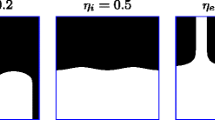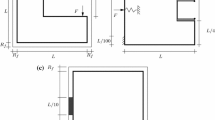Abstract
The maximum size constraint restricts the amount of material within a test region in each point of the design domain, leading to a highly constrained problem. In this work, the local constraints are gathered into a single one using aggregation functions. The challenge of this task is presented in detail, as well as the proposed strategy to address it. The latter is validated on different test problems as the compliance minimization, the minimum thermal compliance, and the compliant mechanism design. These are implemented in the MATLAB software for 2D design domains. As final validation, a 3D compliance minimization problem is also shown. The study includes two well-known aggregation functions, p-mean and p-norm. The comparison of these functions allows a deeper understanding about their behavior. For example, it is shown that they are strongly dependent on the distribution and amount of data. In addition, a new test region is proposed for the maximum size constraint which, in 2D, is a ring instead of a circle around the element under analysis. This slightly change reduces the introduction of holes in the optimized designs, which can contribute to improve manufacturability of maximum size–constrained components.













Similar content being viewed by others
References
Aage N, Andreassen E, Lazarov BS (2015) Topology optimization using petsc: an easy-to-use, fully parallel, open source topology optimization framework. Struct Multidiscip Optim 51(3):565– 572
Almeida SRMd, Paulino GH, Silva ECN (2009) A simple and effective inverse projection scheme for void distribution control in topology optimization. Struct Multidiscip Optim 39(4):359–371
Amir O, Lazarov BS (2018) Achieving stress-constrained topological design via length scale control. Struct Multidiscip Optim 58(5):2053–2071
Andreassen E, Clausen A, Schevenels M, Lazarov BS, Sigmund O (2011) Efficient topology optimization in matlab using 88 lines of code. Struct Multidiscip Optim 43(1):1–16
Bendsøe MP, Kikuchi N (1988) Generating optimal topologies in structural design using a homogenization method. Comput Methods Appl Mech Eng 71(2):197–224
Carstensen JV, Guest JK (2018) Projection-based two-phase minimum and maximum length scale control in topology optimization. Struct Multidiscip Optim 58(5):1845–1860
Deaton JD, Grandhi RV (2014) A survey of structural and multidisciplinary continuum topology optimization: post 2000. Struct Multidiscip Optim 49(1):1–38
Duysinx P, Sigmund O (1998) New developments in handling stress constraints in optimal material distribution. In: 7th AIAA/USAF/NASA/ISSMO symposium on multidisciplinary analysis and optimization, p 4906
Guest J (2009a) Imposing maximum length scale in topology optimization. Struct Multidiscip Optim 37:463–473
Guest JK (2009b) Topology optimization with multiple phase projection. Comput Methods Appl Mech Eng 199(1–4):123– 135
Guest J, Prévost J, Belytschko T (2004) Achieving minimum length scale in topology optimization using nodal design variables and projection functions. Int J Numer Methods Eng 61:238–254
Jansen M, Lombaert G, Schevenels M, Sigmund O (2014) Topology optimization of fail-safe structures using a simplified local damage model. Struct Multidiscip Optim 49:657–666
Lazarov BS, Wang F (2017) Maximum length scale in density based topology optimization. Comput Methods Appl Mech Eng 318:826–844
Lazarov B, Wang F, Sigmund O (2016) Length scale and manufacturability in density-based topology optimization. Arch Appl Mech 86:189–218
París J, Navarrina F, Colominas I, Casteleiro M (2010) Block aggregation of stress constraints in topology optimization of structures. Adv Eng Softw 41(3):433–441
Qian X, Sigmund O (2013) Topological design of electromechanical actuators with robustness toward over-and under-etching. Comput Methods Appl Mech Eng 253:237–251
Rojas-Labanda S, Stolpe M (2015) Automatic penalty continuation in structural topology optimization. Struct Multidiscip Optim 52(6):1205–1221
Sigmund O (2001) A 99 line topology optimization code written in matlab. Struct Multidiscip Optim 21 (2):120–127
Sigmund O (2007) Morphology-based black and white filters for topology optimization. Struct Multidiscip Optim 33(4):401–424
Sigmund O, Maute K (2013) Topology optimization approaches. Struct Multidiscip Optim 48(6):1031–1055
Svanberg K (1987) The method of moving asymptotes—a new method for structural optimization. Int J Numer Methods Eng 24(2):359–373
Talischi C, Paulino GH, Pereira A, Menezes IF (2012) Polytop: a matlab implementation of a general topology optimization framework using unstructured polygonal finite element meshes. Struct Multidiscip Optim 45 (3):329–357
Thompson MK, Moroni G, Vaneker T, Fadel G, Campbell RI, Gibson I, Bernard A, Schulz J, Graf P, Ahuja B et al (2016) Design for additive manufacturing: Trends, opportunities, considerations, and constraints. CIRP Ann-Manuf Technol 65(2):737–760
Verbart A, Langelaar M, Van Keulen F (2017) A unified aggregation and relaxation approach for stress-constrained topology optimization. Struct Multidiscip Optim 55(2):663–679
Wang F, Lazarov BS, Sigmund O (2011) On projection methods, convergence and robust formulations in topology optimization. Struct Multidiscip Optim 43(6):767–784
Wu J, Clausen A, Sigmund O (2017) Minimum compliance topology optimization of shell–infill composites for additive manufacturing. Comput Methods Appl Mech Eng 326:358–375
Wu J, Aage N, Westermann R, Sigmund O (2018) Infill optimization for additive manufacturing—approaching bone-like porous structures. IEEE Trans Vis Comput Graph 24(2):1127–1140
Yan S, Wang F, Sigmund O (2018) On the non-optimality of tree structures for heat conduction. Int J Heat Mass Transf 122:660–680
Yang R, Chen C (1996) Stress-based topology optimization. Struct Optim 12(2–3):98–105
Zhang W, Zhong W, Guo X (2014) An explicit length scale control approach in SIMP-based topology optimization. Comput Methods Appl Mech Eng 282:71–86
Zhou M, Lazarov BS, Wang F, Sigmund O (2015) Minimum length scale in topology optimization by geometric constraints. Comput Methods Appl Mech Eng 293:266–282
Funding
The work was supported by the project AERO+, funded by the Plan Marshall 4.0 and the Walloon Region of Belgium. Computational resources have been provided by the Consortium des Équipements de Calcul Intensif (CÉCI), funded by the Scientific Research Fund of Belgium (F.R.S.-FNRS).
Author information
Authors and Affiliations
Corresponding author
Ethics declarations
Conflict of Interest
The authors declare that they have no conflict of interest.
Additional information
Responsible Editor: James K Guest
Publisher’s note
Springer Nature remains neutral with regard to jurisdictional claims in published maps and institutional affiliations.
Appendix: MATLAB code of the maximum size constraint
Appendix: MATLAB code of the maximum size constraint

Rights and permissions
About this article
Cite this article
Fernández, E., Collet, M., Alarcón, P. et al. An aggregation strategy of maximum size constraints in density-based topology optimization. Struct Multidisc Optim 60, 2113–2130 (2019). https://doi.org/10.1007/s00158-019-02313-8
Received:
Revised:
Accepted:
Published:
Issue Date:
DOI: https://doi.org/10.1007/s00158-019-02313-8




